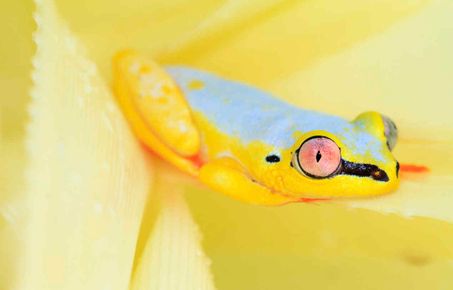Ecology and management of wildlife pandemics
Infectious diseases can have catastrophic impacts on biodiversity, causing population declines and extinctions of wild species and increasing vulnerability of populations to existing pressures. Many of the risks that wild species face due to infectious diseases are enhanced or arise due to human activities, including habitat degradation and fragmentation, climate change, global trade, and local activities that can facilitate spread. These factors also commonly contribute to infectious disease threats to humans, many of which originate in wildlife as zoonoses. Pandemics of every kind thus represent a globally significant threat to health security.
Chytridiomycosis and other emerging fungal infections
--tojpeg_1432903555004_x2.jpg)
Amphibian chytridiomycosis has been described as the most significant disease of vertebrates in recorded history, causing widespread extinctions and catastrophic population declines across the globe. The emergence of the fungal pathogen causing this disease (Batrachochytrium dendrobatidis) has been driven by the extensive trade in amphibian species, which allowed opportunities for pathogen mixing and the global spread of a virulent pandemic strain. Distribution and impacts of the disease are mediated by a huge range of factors, including life-history and ecological traits of affected species and numerous environmental factors (e.g., climate and temperature extremes and variability).
We are studying numerous aspects of the ecology and management of chytridiomycosis, including the risks associated with the wildlife trade and biosecurity strategies, risk factor analyses of infection in wild and laboratory settings, understanding and dating the origins of the pandemic strain, and developing global collaborative networks to develop research on this, and other, emerging pathogenic fungi in wildlife, including chytridiomycosis in salamanders (caused by a related chytrid species, B. salamandrivorans) and white-nose syndrome in bats (also caused by a fungus, Pseudogymnoascus destructans). We are also widely engaged with policy makers in order to advise on national and international strategies to mitigate the threat of novel infectious diseases in wildlife.
Selected publications
Selected publications
Langwig KF, Voyles J, Wilber MQ, Frick, WF, Murray KA, Bolker BM, Collins JP, Cheng TL, Fisher MC, Hoyt JR, Lindner DL, McCallum HI, Puschendorf R, Rosenblum EB, Toothman M, Willis CKR, Briggs CJ, Kilpatrick AM. (2015). Context-dependent conservation responses to emerging wildlife diseases. Frontiers in Ecology and the Environment 13 (4): 195-202.
Martel A, Blooi M, Adriaensen C, Van Rooij P, Beukema W, Fisher MC, Farrer RA, Schmidt BR, Tobler U, Goka K, Lips KR, Muletz C, Zamudio K, Bosch J, Lötters S, Wombwell E, Garner TWJ, Cunningham AA, Spitzen-van der Sluijs A, Salvidio S, Ducatelle R, Nishikawa K, Nguyen TT, Kolby JE, Van Bocxlaer I, Bossuyt F, Pasmans F (2014). Recent introduction of a chytrid fungus endangers Western Palearctic salamanders. Science Vol. 346 no. 6209 pp. 630-631 DOI: 10.1126/science.1258268
Voyles J, Kilpatrick AM, Collins JP, Fisher MC, Frick WF, McCallum HI, Willis CKR, Blehert DS, Murray KA, Puschendorf R, Rosenblum EB, Bolker BM, Cheng TL, Langwig KE, Lindner DL, Toothman M, Wilber MQ, Briggs CJ. (2014). Moving beyond too little, too late: Managing emerging infectious diseases in wild populations requires international policy and partnerships. EcoHealth, 1-4. DOI:10.1007/s10393-014-0980-5
Baláž V, Vörös J, Civiš P, Voja J, Hettyey A, Sós E, Dankovics R, Jehle R, Christiansen DG, Clare F, Fisher MC, Garner TWJ, Bielby J (2014) Assessing risk and guidance on monitoring of Batrachochytrium dendrobatidis in Europe through identification of taxonomic selectivity of infection. Conservation Biology, 28, 213-223
Murray KA, Skerratt LF, Garland S, Kriticos D, McCallum HI. (2013). Whether the Weather Drives Patterns of Endemic Amphibian Chytridiomycosis: A Pathogen Proliferation Approach. PLoS One 8 (4), e61061
Fisher MC, Henk DA, Briggs C, Brownstein JS, Madoff L, McCraw SL, Gurr S. (2012) Emerging fungal threats to animal, plant and ecosystem health. Nature 484: 186-194
Murray KA, Skerratt LF. (2012). Predicting wild hosts for amphibian chytridiomycosis: integrating host life-history traits with pathogen environmental requirements.Human and Ecological Risk Assessment: An International Journal 18 (1), 200-224
Farrer RA, Weinert LA, Bielby J, Garner TWJ, Balloux F, Clare F, Bosch J, Cunningham AA, Weldon C, du Preez LH, Anderson L, Kosakovsky Pond SL, Shahar-Golan R, Henk DA, Fisher MC. (2011) Multiple emergences of genetically diverse amphibian-infecting chytrids include a globalised hypervirulent recombinant lineage. PNAS 108(46) 18732-18736
Garner TWJ, Rowcliffe JM, Fisher MC (2011) Climate, chytridiomycosis or condition: an experimental test of amphibian survival. Global Change Biology, 17, 667-675
LP Shoo, DH Olson, SK McMenamin, KA Murray, M Van Sluys, Donnelly MA, Stratford D, Terhivuo J, Merino‐Viteri A, Herbert SM, Bishop PJ, Corn PS, Dovey L, Griffiths RA, Lowe K, Mahony M, McCallum HI, Shuker JD, Simpkins C, Skerratt LF, Williams SE, Hero JM (2011). Engineering a future for amphibians under climate change. Journal of Applied Ecology 48 (2), 487-492
Murray KA, Retallick RWR, Puschendorf R, Skerratt LF, Rosauer D, McCallum HI, Berger L, Speare R, VanDerWal J. (2011). Assessing spatial patterns of disease risk to biodiversity: implications for the management of the amphibian pathogen, Batrachochytrium dendrobatidis. Journal of Applied Ecology 48 (1), 163-173
Walker SF, Bosch J, Gomez V, Garner TWJ, Cunningham AA, Schmeller DS, Ninyerola M, Henk D, Ginestet C, Christian-Philippe A, Fisher MC (2010) Factors driving pathogenicity versus prevalence of the amphibian pathogen Batrachochytrium dendrobatidis and chytridiomycosis in Iberia. Ecology Letters, 13, 372-382




